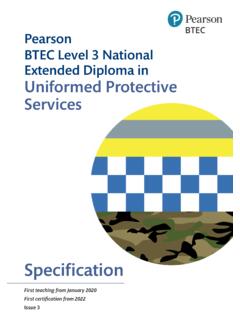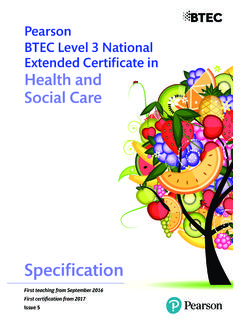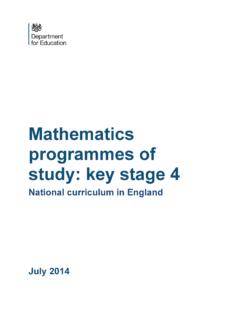Transcription of Specification of apprenticeship standards for England
1 Specification of apprenticeship standards for England August 2018 2 Contents Summary 3 About this guidance 3 Review date 3 What legislation does this guidance refer to? 3 Who is this guidance for? 3 Main points 3 Intermediate Level apprenticeship Frameworks 5 Qualifications Related to the Sector 5 Functional Skills/GCSE/Other Alternatives 7 Information and Communications Technology (ICT) 11 Employee Rights and Responsibilities (ERR) 11 Personal Learning and Thinking Skills (PLTS) 13 On-the-Job Training and Off-the-Job Training Guided Learning Hours (GLH) 14 Exceptions to the English and Maths Regular Minimum Requirements for People with Special Educational Needs, Learning Difficulties or Disabilities 15 Advanced Level Apprentice Framework 17 Employee Rights and Responsibilities (ERR)
2 17 Functional Skills/GCSE/Other Alternatives 18 Information and Communications Technology (ICT) 22 Employee Rights and Responsibilities (ERR) 22 Personal Learning and Thinking Skills (PLTS) 22 On-the-Job Training and Off-the-Job Training 22 Guided Learning Hours (GLH) 22 Exceptions to the English and Maths Regular Minimum Requirements for People with Special Educational Needs, Learning Difficulties or Disabilities 23 higher apprenticeship Framework 25 3 Summary About this guidance The Specification of apprenticeship standards for England (SASE) sets out the minimum requirements to be included in a recognised English framework. Compliance with the SASE is a statutory requirement of the Apprenticeships, Skills, Children and Learning Act 2009.
3 This is the seventh version of the statutory SASE. It includes further qualifications as recognised English, maths and ICT prior attainment for apprenticeship frameworks. These modifications are set out in paragraphs 5 10 and 31 35. It will be brought into effect by order issued by the Secretary of State. Review date This guidance will be reviewed periodically. What legislation does this guidance refer to? The apprenticeship , Skills, Children and Learning Act (ASCLA) 2009. Who is this guidance for? This guidance is for: Training Providers Employers Main points This version of SASE takes effect when the Apprenticeships (Modification to the Specification of apprenticeship standards for England ) Order 2018 comes into force.
4 The list of accepted English, maths and ICT equivalent qualifications has been expanded to include: o Additional Scottish qualifications o Equivalent International Baccalaureate qualifications o Relevant International qualifications 4 o CSE o Free Standing Maths and Core Maths o Pre-U qualifications o Computer Science GCSE. The changes will apply to those starting an apprenticeship after the Apprenticeships (Modification to the Specification of apprenticeship standards for England ) Order 2018 has come into force and, pursuant to an appropriate direction made under section 13 of the Apprenticeships, Skills, Children and Learning Act 2009 to the certification authority, to those currently on an apprenticeship but who have not yet completed their apprenticeship prior to the Order coming into force.
5 5 Intermediate Level apprenticeship Frameworks Qualifications Related to the Sector ASCLA Reference 1. An Intermediate Level apprenticeship framework must specify the total number of credits which an apprentice must attain for a qualification on the Regulated Qualifications Framework (RQF). This must be at a minimum of 37 credits. Section 27 (2) (a) 2. An Intermediate Level apprenticeship framework must identify the competencies qualification which must be achieved by the apprentice to qualify for an apprenticeship certificate, and which is the qualification required to demonstrate competence in performing the skill, trade or occupation to which the framework relates.
6 The competencies qualification must be at Level 2 of the RQF, underpinned by national Occupational standards (NOS), and be approved by the relevant Sector Skills Council (SSC) or Sector Body. To avoid duplication of frameworks in the same skill, trade or occupation, each framework must have a different competencies qualification. Section 27 (2) (c) ( iii) 3. An Intermediate Level apprenticeship framework must identify a technical knowledge qualification which must be achieved by the apprentice to qualify for an apprenticeship certificate. A technical knowledge qualification is the qualification required to demonstrate achievement of the technical skills, knowledge and understanding of theoretical concepts and knowledge and understanding of the industry and its market relevant to the skill, trade or occupation to which the framework relates.
7 The technical knowledge qualification must be underpinned by national Occupational standards (NOS); and be approved by the relevant Sector Skills Council (SSC) or Sector Body. Section 27 (2) (c) (ii) 6 ASCLA Reference 4. An Intermediate Level apprenticeship framework must identify either: a) a competencies qualification at level 2 and a separate technical knowledge qualification, each of which must carry at least ten credits on the RQF or; b) an integrated qualification at level 2 which combines competence and technical knowledge elements in which each element carries at least ten credits on the RQF. Section 27 (2) (c) (ii) Section 27 (2) (a) 7 Functional Skills/GCSE/Other Alternatives 5.
8 In accordance with ASCLA Section 27 (2) (c) (i), an Intermediate Level apprenticeship framework must specify that an apprentice must achieve (or have achieved) at least one English1 and maths qualification from the following minimum options: Qualifications English Maths Minimum acceptable grade GCSE2 Any GCSE with English in the title Any GCSE with Mathematics in the title E or 23 International GCSE Any International GCSE with English in the title Any International GCSE with Mathematics in the title E or 2 Functional Skills level 1 English Mathematics Pass Key Skills level 1 Communication (Literacy) Application of Number (Numeracy) Pass A Level Any A Level with English in the title Any A Level with Mathematics in the title E or Ordinary Grade (pre 1986)
9 AS Level Any AS Level with English in the title Any AS Level with Mathematics in the title E Core Maths level 34 - Mathematical Studies Using and Applying Mathematics Quantitative Problem Solving Quantitative Reasoning Mathematics in Context Mathematics for Work and Life E 1 All English qualifications should refer only to those qualifications where English is the primary language, unless explicitly stated. 2 Regulated by Ofqual, CCEA and Qualifications Wales. 3 From 2017; where 9 to 1 grading scale is used. 4 Where included in Performance Tables. 8 Qualifications English Maths Minimum acceptable grade Free-Standing Maths level 2 - Level 2 Free-Standing Mathematics Qualification - Foundations of Advanced Mathematics E Pre U Certificate Literature in English Mathematics Further Mathematics P3 O Level English language English literature Mathematics E (pre 1975 evidence of a Pass) CSE English Mathematics 2 or 3 British Sign Language5 (Regulated Qualifications Framework level 1) (Scottish Credit & Qualifications Framework level 4)
10 British Sign Language - Pass Essential Skills Wales level 1 Essential Communication Skills or Essential Skills Wales in Communication Essential Application of Number Skills or Essential Skills Wales in Application of Number Pass Essential Skills (Northern Ireland) level 1 Certificate in Essential Skills Communication Certificate in Essential Skills Application of Number Pass Scottish Advanced higher (SCQF level 7) English Mathematics C Scottish higher (SCQF level 6) English Mathematics C Scottish national 4 English Mathematics Pass 5 Where British Sign Language is primary language. 9 Qualifications English Maths Minimum acceptable grade (SCQF level 4) Life skills Mathematics Applications of Mathematics Scottish Intermediate 1 (SCQF level 4) English Mathematics C Scottish Standard Grade General (SCQF level 4) English Mathematics 3 Scottish national Certificate Unit (SCQF level 6) Communication 4 - Pass Scottish Core Skill Unit (SCQF level 4) Communication Numeracy Pass Scottish Workplace Core Skill Unit (SCQF level 4) Communication Numeracy Pass Scottish national Unit (SCQF level 4) Literacy Numeracy Pass Scottish Ordinary Grade (SCQF level 5)













